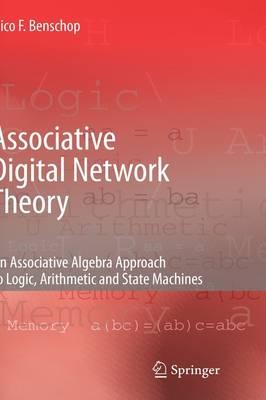Overview
""Associative Digital Network Theory"" is intended for researchers at industrial laboratories, teachers and students at technical universities, in electrical engineering, computer science and applied mathematics departments, interested in new developments of modeling and designing digital networks (DN: state machines, sequential and combinational logic) in general, as a combined math/engineering discipline. As background an undergraduate level of modern applied algebra (Birkhoff-Bartee: ""Modern Applied Algebra"" - 1970, and Hartmanis-Stearns: ""Algebraic Structure of Sequential Machines"" - 1970) will suffice. Essential concepts and their engineering interpretation are introduced in a practical fashion with examples. The motivation in essence is: the importance of the unifying associative algebra of function composition (viz. semigoup theory) for the practical characterisation of the three main functions in computers, namely sequential logic (state-machines), arithmetic and combinational (Boolean) logic.
Full Product Details
Author: Nico F. Benschop
Publisher: Springer-Verlag New York Inc.
Imprint: Springer-Verlag New York Inc.
Dimensions:
Width: 15.50cm
, Height: 1.20cm
, Length: 23.50cm
Weight: 0.454kg
ISBN: 9781402098284
ISBN 10: 1402098286
Pages: 192
Publication Date: 15 April 2009
Audience:
Professional and scholarly
,
Professional & Vocational
Format: Hardback
Publisher's Status: Out of Print
Availability: Out of stock

Reviews
From the reviews: Benschop develops this thesis in an idiosyncratic fashion, reinforced by a long career of practical experience. This book may well be an important historical document, also useful for seminars . There are profuse illustrations in classic number theory, as well as claims that the outlook sheds new light on classic problems such as those of Fermat and Goldbach, interpreted as machines. it makes for an interesting book. (Harvey Cohn, ACM Computing Reviews, August, 2009) The book presents new ways for modeling digital networks (state machines, sequential and combinational logic). It contains applications for known principles of the discrete mathematics. book also presents new ideas on the finite additive number theory and a binary logarithmetic microprocessor. This book can be very useful for students and professors and also for researchers interested in the digital network theory. It covers a lot of fields, ranging from electrical engineering to computer science and applied mathematics. (Eleonor Ciurea, Zentralblatt MATH, Vol. 1169, 2009)
From the reviews: Benschop develops this thesis in an idiosyncratic fashion, reinforced by a long career of practical experience. This book may well be an important historical document, also useful for seminars . There are profuse illustrations in classic number theory, as well as claims that the outlook sheds new light on classic problems such as those of Fermat and Goldbach, interpreted as machines. it makes for an interesting book. (Harvey Cohn, ACM Computing Reviews, August, 2009) The book presents new ways for modeling digital networks (state machines, sequential and combinational logic). It contains applications for known principles of the discrete mathematics. book also presents new ideas on the finite additive number theory and a binary logarithmetic microprocessor. This book can be very useful for students and professors and also for researchers interested in the digital network theory. It covers a lot of fields, ranging from electrical engineering to computer science and applied mathematics. (Eleonor Ciurea, Zentralblatt MATH, Vol. 1169, 2009)
From the reviews: ""Benschop develops this thesis in an idiosyncratic fashion, reinforced by a long career of practical experience. This book may well be an important historical document, also useful for seminars . There are profuse illustrations in classic number theory, as well as claims that the outlook sheds new light on classic problems such as those of Fermat and Goldbach, interpreted as machines. it makes for an interesting book."" (Harvey Cohn, ACM Computing Reviews, August, 2009) The book presents new ways for modeling digital networks (state machines, sequential and combinational logic). It contains applications for known principles of the discrete mathematics. book also presents new ideas on the finite additive number theory and a binary logarithmetic microprocessor. This book can be very useful for students and professors and also for researchers interested in the digital network theory. It covers a lot of fields, ranging from electrical engineering to computer science and applied mathematics. (Eleonor Ciurea, Zentralblatt MATH, Vol. 1169, 2009)""
Author Information
Dr. Nico Benschop worked at Philips research (NatLab) for 32 years, working in the VLSI Digital Design Department. He received his MSc. at the Technical University of Delft, Netherlands and his PhD at Waterloo University in Ontario, Canada.




